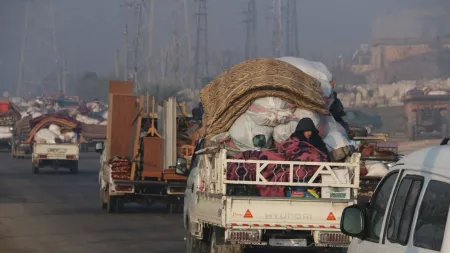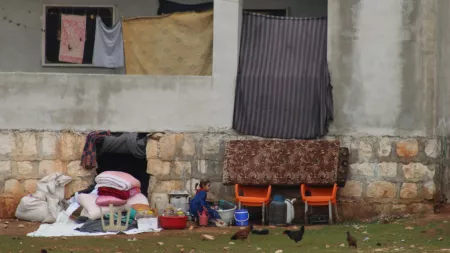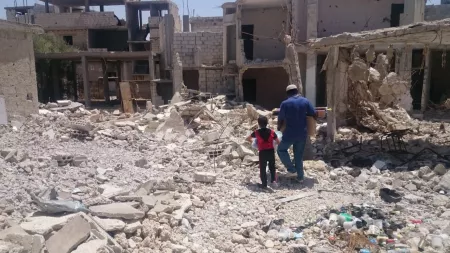Twelve years later, the conflict in Syria that erupted in March 2011 has killed approximately 300,000 civilians, displaced more than 13 million people, and left majority of the population in need of humanitarian assistance.
Humanitarian needs have been made more acute by the onset of devastating earthquakes more than a month ago, crippling vulnerable communities in Syria and across the border in neighboring Türkiye, where many Syrian refugees reside. Almost 10% of the people who died in the earthquakes are reported to be Syrian.
Before the earthquakes, the situation in Syria was already described as one of the worst humanitarian crises of our time. Today, there are several concurrent humanitarian crises in Syria: an earthquake, a cholera outbreak threatening 1.2 million people, catastrophic living conditions owing to more than a decade of protracted conflict, and climate-induced crises. In 2022, the United Nations (UN) estimated that 15.3 million people will need humanitarian assistance this year – a five percent increase compared to the previous year. Today the number will likely be much higher due to the new wave of destruction and displacement caused by the earthquakes.
As expressed by Sherine Ibrahim, CARE Türkiye Country Director, "prior to the earthquakes that struck on 6th February, women in northwest Syria were already shouldering the burden of conflict and resulting displacement, as well as the duty of care towards their families amid lack of access to livelihood opportunities. Now women and vulnerable communities across both northwest Syria and Türkiye are enduring additional trauma and debilitating new burdens."
"It is a tragedy atop a tragedy and it is clear today that the immediate as well as long-term consequences of this new evolving humanitarian crisis will have far reaching negative impacts on their mental health, and their physical and social well-being."said Sherine Ibrahim, CARE Türkiye Country Director.
The conflict has caused large scale displacement – the UN’s refugee agency estimates that 6.8 million people have been forced to flee the country since 2011, either because of the violence, the lack of livelihood and income generating sources, or the declining living standards. Approximately 80% of those (5.4 million) who fled the country are refugees registered in neighboring countries Türkiye, Jordan and Lebanon – more than half of which are in Türkiye. In addition to having the largest refugee population in the world, Syria has the largest number of internally displaced people (IDP), 6.8 million.
Today, almost 2.1 million IDPs (or approximately 31% of the total IDP population), live in ‘last resort’ sites in northwest and northeast Syria and need life-saving assistance. In northwest Syria, 80% of those living in those sites are women and children. Lifesaving assistance in northwest Syria hangs in the balance as the UN Security Council once again begins to deliberate in June of this year whether to authorize and fund cross-border assistance from neighbouring Türkiye.

CARE's response
CARE and partners have been working in northwest Syria and Türkiye since 2013 to deliver a wide range of community-led programs that provide both emergency assistance and longer-term support to both displaced and host communities alike. In the last fiscal year, CARE reached more than 700,000 people in Türkiye, 57.7% of whom are girls and women, and more than 1.8 million people in Syria, 53% of whom are women and girls.
CARE has also expanded its presence to reach areas in northeast Syria in 2017 by providing emergency assistance and generating livelihood activities for vulnerable communities, most of whom live in IDP sites that are notorious for overcrowding and a precarious security situation.
Internally displaced people represented almost one quarter of the population in northeast Syria (nearly 630,000). CARE supports more than one million people, including both IDPs and host communities, in northeast Syria to meet their emergency needs. Over 90% of the population of the northeast region live below the poverty line and 69% do not have access to adequate water supply, while 95% of camps do not have adequate infrastructure such as women and girls’ friendly space and gender segregated bathrooms.
“CARE works on delivering assistance to the most vulnerable communities, including those, who live in what are described as last-resort sites,” said Jolien Veldwijk, CARE Syria Country Director. “Without humanitarian assistance those communities would not be able to secure their most basic needs – such as water for drinking and washing, or shelter that would withstand the harsh winter conditions – let alone find a means to generate a meagre income that would make for a dignified form of assistance and give people the agency to build their own livelihoods and resilience.”

Programs are focused on emergency cash, voucher and in-kind food and material assistance; water, sanitation and hygiene services targeting the prevention of the outbreak of diseases like cholera; shelter support; sexual and reproductive health services; protection and gender-based violence support; and livelihoods and economic recovery assistance through various initiatives re-engaging local communities in the agricultural sector and offering dignified means of assistance that strengthen women’s abilities to respond to crises.
CARE also operates in Jordan, where almost 700,000 Syrian refugees reside, by supporting approximately 45,000 individuals at the Azraq refugee camp to meet their needs.
Twelve years on, CARE calls for a more comprehensive approach to humanitarian assistance in Syria. The response must adapt to the changing needs of people enduring more than a decade of protracted displacement and insecurity. Specifically, the humanitarian community needs greater investment in dignified living conditions and economic empowerment for women and girls who are taking on greater burdens as the humanitarian conditions continue to decline.
For media inquiries, please contact Sulafah Al-Shami, Syria Reponse Senior Communications Manager Coordinator via: [email protected].
